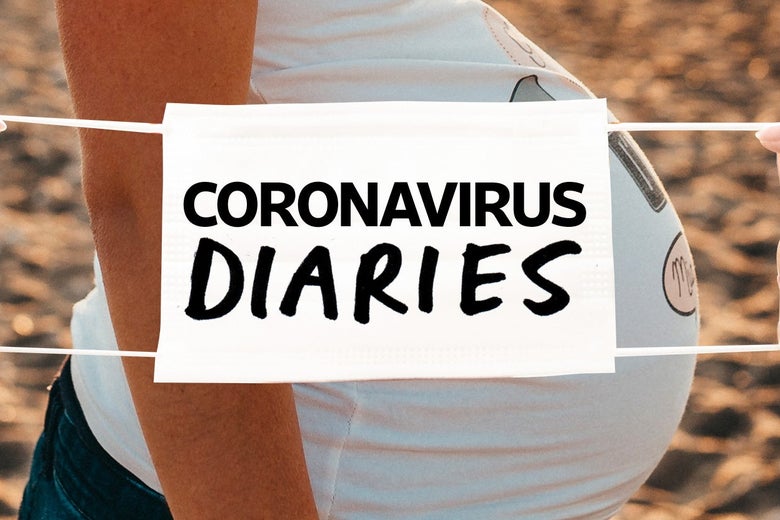
Photo illustration by Slate. Photo by Xavier Mouton Photographie on Unsplash.
Coronavirus Diaries is a series of dispatches exploring how the coronavirus is affecting people’s lives. For the latest public health information, please refer to the Centers for Disease Control and Prevention’s website. For Slate’s coronavirus coverage, click here.
When I told my mom I was pregnant this fall, she kvelled, cried, and selected “Grammy” as her future title. Then flu season arrived. Her weekly “happy Monday!” texts started coming with handwashing tutorials, tips on knuckling vs. pushing elevator buttons, and advice that sounded ludicrous to me at the time: “avoid the general public.”
I took a few steps to appease her, attaching a travel-size Purell to my keychain and buying prescription compression stockings to ease her worry about my varicose veins during pregnancy. But mostly I’ve been lovingly mocking her for months. Until now, when the rise of COVID-19 has actual health experts mandating that everyone socially distance ourselves from our friends, colleagues, neighbors, and, yes, the general public. I guess mother does occasionally know best.
I’m 31 weeks pregnant. Every day I watch my belly grow along with this virus—and the global frenzy and fallout that comes with a highly contagious pandemic. Like everyone, I’m attempting to process what this means for my community, how I can take steps to support the most vulnerable, and how much precautionary Purell is reasonable. Like other women growing tiny brains and lungs inside of them, I’m trying to figure out if this means something especially scary for me. The CDC says, “We do not currently know if pregnant women have a greater chance of getting sick from COVID-19 than the general public nor whether they are more likely to have serious illness as a result. … It is always important for pregnant women to protect themselves from illnesses.” Meaning, regardless of how much I consult Dr. Google—or actual physicians, for that matter—nobody really knows.
I’m fortunate in so many ways. I have a loving, supportive partner whose insurance covers our medical bills. We can cough up the $15 to take a Lyft to doctors’ appointments, don’t have other dependents, and can work remotely. We’ve stockpiled Huggies in the unlikely event that there’s a shortage and tossed some antiviral wipes into our hospital bag. But I also fear what has been on my mother’s mind all along: that I’m exposing the coconut-sized human rapidly developing inside me to vulnerabilities and unknowns.
Part of being pregnant for the first time is not knowing what to expect. Will my water break on its own? How painful will labor be? What will my life be like the day after, and all the days after that? This virus, and the anxiety, uncertainty, and emergencies it’s presenting, are, I suppose, a lesson that most new parents discover: You can only prepare so much. I long for a risk calculator or a definitive app to guide me. A place to weigh whether the amount of Lysol I’m spraying is productive or wasteful. But the rules are constantly changing, and the precautions have their limits. A few weeks ago, my OB/GYN advised me to avoid gatherings of more than 20 people, which I appreciated until I found her waiting room packed with close to 30. It’s moments like these when I find myself trying to calibrate my anxiety, to talk myself down. Stress, after all, is also bad for the baby.
Some days I can zoom out and remember that people all over the world have been doing the best they can at this for a long time, often in trying circumstances and always with uncertainties. Other days, I spiral into worse-case scenario mode and can only zoom in.
Sunday was one of the bad days. I learned that, in order to reduce coronavirus exposure, the hospital where I will be delivering is no longer allowing partners to be present during labor, or to visit at all. If I go into labor tomorrow, I’ll be ushered into a room, swabbed for COVID, and given a mask. I know there will be wonderful doctors and nurses there to take care of me. But the thought that my husband may not be there to hold my hand and hear our son’s first cry is terrifying.
This was not in any of the pregnancy books. Yet, like everyone right now, we’re trying to adapt. After some tears and a brief period of scanning Amazon for umbilical cord scissors for home births, and then for a hospital bag large enough to smuggle in my husband, we started to come back down to earth.
Our son is due on Memorial Day. Who knows what the world will look like then? Will we have banded together to 3D print enough ventilator valves and face masks to accommodate those who need them? Will it be safe for my parents and in-laws to hold their grandson? On the day he is born, how many people will have the virus? How many will have died? The answers are as uncertain as whether my kid will be late, early, or right on time.
For now, I’ll do my best to stay healthy, connected, and calm because that’s what’s best for the baby. I’m trying to look ahead to what feels as close to sure as we can get these days, instead of into the terrifying unknowns: Soon, the little person inside of me will arrive in the world, and my husband and I will have a child to love.
Readers like you make our work possible. Help us continue to provide the reporting, commentary and criticism you won’t find anywhere else.
Join Slate Plusfrom Slate Magazine https://ift.tt/3994U5j
via IFTTT
沒有留言:
張貼留言